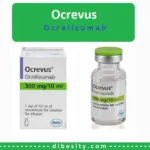Tysabri (Natalizumab) is a monoclonal antibody directed against integrin receptors. It binds specifically to the α4 subunit of the α4ß1 and α4ß7 integrin receptors.
Integrin receptors are widely present on the endothelial surface of vessels but most abundant on the vascular endothelial surface of the gastrointestinal tract and parenchymal cells of the brain.
VCAM-1 (vascular cell adhesion molecule-1) and MAdCAM-1 (mucosal addressin cell adhesion molecule-1) are present on the vascular endothelial surface and the vascular endothelial surface of the gastrointestinal tract.
Thus Tysabri (Natalizumab), blocks leukocytes (that express integrin receptors) from binding to the extracellular matrix and parenchymal cells.
The net result is a reduction in the inflammatory response and recruitment of inflammatory cells to the site of inflammation.
| You may also like to read: |
Tysabri (Natalizumab) Use:
Tysabri is indicated in the treatment of the following medical conditions:
Multiple Sclerosis:
Tysabri is used to treat a subtype of Multiple Sclerosis (MS) called Relapsing Multiple Sclerosis. The efficacy of Tysabri in the treatment of the chronic progressive form of MS has not been established.
In addition, Tysabri treatment beyond two years is not known. It may be used as a monotherapy in relapsing MS, however, it is best to use it if a patient with MS has failed other alternative therapies recommended for MS.
Because of the risk of PML (progressive multifocal leukoencephalopathy), it is recommended to use if other alternative drugs have failed.
PML is a serious viral infection of the brain that is associated with severe disability and sometimes death of the patient.
Crohn’s Disease:
Tysabri (Natalizumab) is indicated for the treatment of Crohn’s disease that is moderate to severe and not responsive to conventional treatment of Crohn’s disease and TNF inhibitors.
It helps in inducing remission and is also used to maintain remission in such cases. It is not recommended to be used with immunosuppressants like:
- Azathioprine (Imuran)
- 6-Mercaptopurine
- Cyclosporin (Sandimmune, Neoral)
- Methotrexate
- TNF-α Inhibitors
Summary of Indications of Tysabri (Natalizumab):
Indications of Tysabri (Natalizumab) | Remarks |
| Multiple Sclerosis |
|
| Crohn’s Disease |
|
| You may also like to read: |
Tysabri (Natalizumab) Dosage and Administration:
Physicians who are registered in the MS and CD Touch program are allowed to prescribe Tysabri (Natalizumab) only.
Dosage forms available:
Tysabri (Natalizumab) is available in a vial containing 300 mg per 15 ml sterile solution (20 mg/ml) without any preservatives. Each vial is to be used only once.
Tysabri Dose in MS and Crohns Disease:
Tysabri Indication | Tysabri Dose |
| Multiple Sclerosis | 300 mg intravenously over one hour. The dose is repeated every 4 weeks (once a month). The drug is approved for the treatment of MS and is available only to physicians registered with MS Touch Prescribing Program for MS |
| Crohn’s Disease | 300 mg intravenously over one hour. The dose is repeated every 4 weeks (once a month). The drug is approved for the treatment of MS and is available only to physicians registered with MS Touch Prescribing Program for Crohn’s Disease. It is not recommended with other immunosuppressants except for aminosalicylates and corticosteroids. Treatment may be stopped if little or no benefit is observed after 12 weeks (3 months) of the treatment. In addition, treatment may be discontinued if the dose of corticosteroids can not be tapered off within 6 months. |
How to make the infusion before administering it?
The infusion is made by properly following an aseptic protocol. 15 ml of the drug is withdrawn from the vial and injected into a bag of 100 ml 0.9% saline.
The final solution is then gently mixed by inverting the bag slightly. The infusion, once prepared, should be administered immediately over one hour.
If not administered immediately, it must be refrigerated at 2 – 8 C. The solution can be kept for up to 8 hours following the preparation.
If refrigerated, warm it before infusing it by keeping it at room temperature for some time.
How to administer the infusion?
Once the infusion is made, its concentration is 2.61 mg/ml (300 mg/115 ml). It is administered as a slow intravenous infusion over one hour. Avoid giving it as an intravenous push.
It is important to observe the patient for any side effects and infusion-related allergic reactions.
| You may also like to read: |
Tysabri (Natalizumab) Use in Pregnancy and Breastfeeding:
Natalizumab is a pregnancy-risk category C drug. This means that the drug has not been evaluated properly in pregnant women.
In animal studies, it was associated with significant blood-related side effects when it was administered at 7 times the normal dose [Ref].
Tysabri has also been detected in breast milk. However, it is not known if it has significant effects on the breastfed child or not. One reason for this is that it enters the child’s GI tract while normally, it is administered intravenously.
| You may also like to read: |
Tysabri (Natalizumab) Contraindications and Side effects:
Tysabri (Natalizumab) is contraindicated in the following groups of patients:
- PML (progressive multifocal leukoencephalopathy)
- Patients allergic to the drug
In addition, before initiating Natalizumab treatment, one should exclude the following medical conditions and be extremely cautious when the treatment is begun:
- Infections
- Immunosuppression
- Hepatotoxicity
- Laboratory changes may occur including blood dyscrasias
Immunization may be delayed when Natalizumab treatment is given.
Other side effects of Tysabri (Natalizumab) include:
General Side effects:
- Fatigue
- Chest discomfort
- Seasonal allergy and other allergic reactions
- Rigors and chills
- Weight gain or weight loss
Infections:
- Urinary tract infections
- Lower respiratory tract infections
- Vaginitis
- Gastroenteritis
- Herpes infection
- Tooth infection
- Tonsillitis
Psychiatric symptoms:
- Depression
Musculoskeletal symptoms:
- Limb pain
- Arthralgia
- Arthritis
- Muscle cramps
GI side effects:
- Abdominal pain
- Diarrhea
- Elevated liver functions
Skin-related side effects:
- Skin rash
- Eczema
- Sweating
- Pruritis
Gynecological side effects:
- Irregular menstrual cycles
- Amenorrhea
- Dysmenorrhea
- Oligomenorrhea
- Ovarian cyst
Neurological side effects:
- Somnolence
- Vertigo
- Headache
Renal side effects:
- Urinary incontinence
- Urinary urgency
- Urinary frequency
| You may also like to read: |
Tysabri (Natalizumab) Monitoring Parameters:
Monitor the patient for any allergic reactions during the infusion.
All patients must be screened for infections before treatment initiation.
During therapy, any symptoms suggestive of infection such as fever, diarrhea, burning micturition, cough, phlegm production, chest pain, or non-healing wounds must prompt early intervention, treatment discontinuation, or treatment break.
Among infection-related side effects, PML is a very serious infection. All patients must be kept under observation for new-onset neurological symptoms.
Liver functions and blood tests should be done at periodic intervals.
| You may also like to read: |
Tysabri (Natalizumab) MOA (Mechanism of action):
Tysabri (Natalizumab) is a humanized monoclonal IgG4κ antibody that binds to the α4 subunit of α4β1 and α4β7 integrins expressed on the surface of white blood cells except for neutrophils.
Natalizumab inhibits the binding of leukocytes to their cell surfaces that are present in the vascular and mucosal endothelial cells.
When Natalizumab blocks these integrin receptors, leukocytes are unable to migrate to tissues where the inflammatory process is going on.
The exact mechanism of action of Natalizumab in the management of Multiple Sclerosis and Crohn’s diseases is not known.
However, the inhibition of α4β1 integrin receptors expressed by leukocytes and vascular endothelium (VCAM-1) may be responsible for the anti-inflammatory effects as the inflammatory cells would not enter the brain parenchyma.
Similarly, in patients with Crohn’s disease, the α4β7 integrins expressed on the surface of white blood cells can not interact with mucosal addressin cell adhesion molecules-1 (MadCAM-1) because of the inhibitory effects of Natalizumab.
This results in reduced cellular migration to the inflammatory sites. Inflammatory processes are markedly suppressed.
| You may also like to read: |
Tysabri (Natalizumab) Brands and Price:
There are no alternate brands of Natalizumab other than Tysabri. It is available as a Tysabri injection containing 300 mg/15 ml vial.
The cost of each vial is about USD 8000 $ without insurance.




